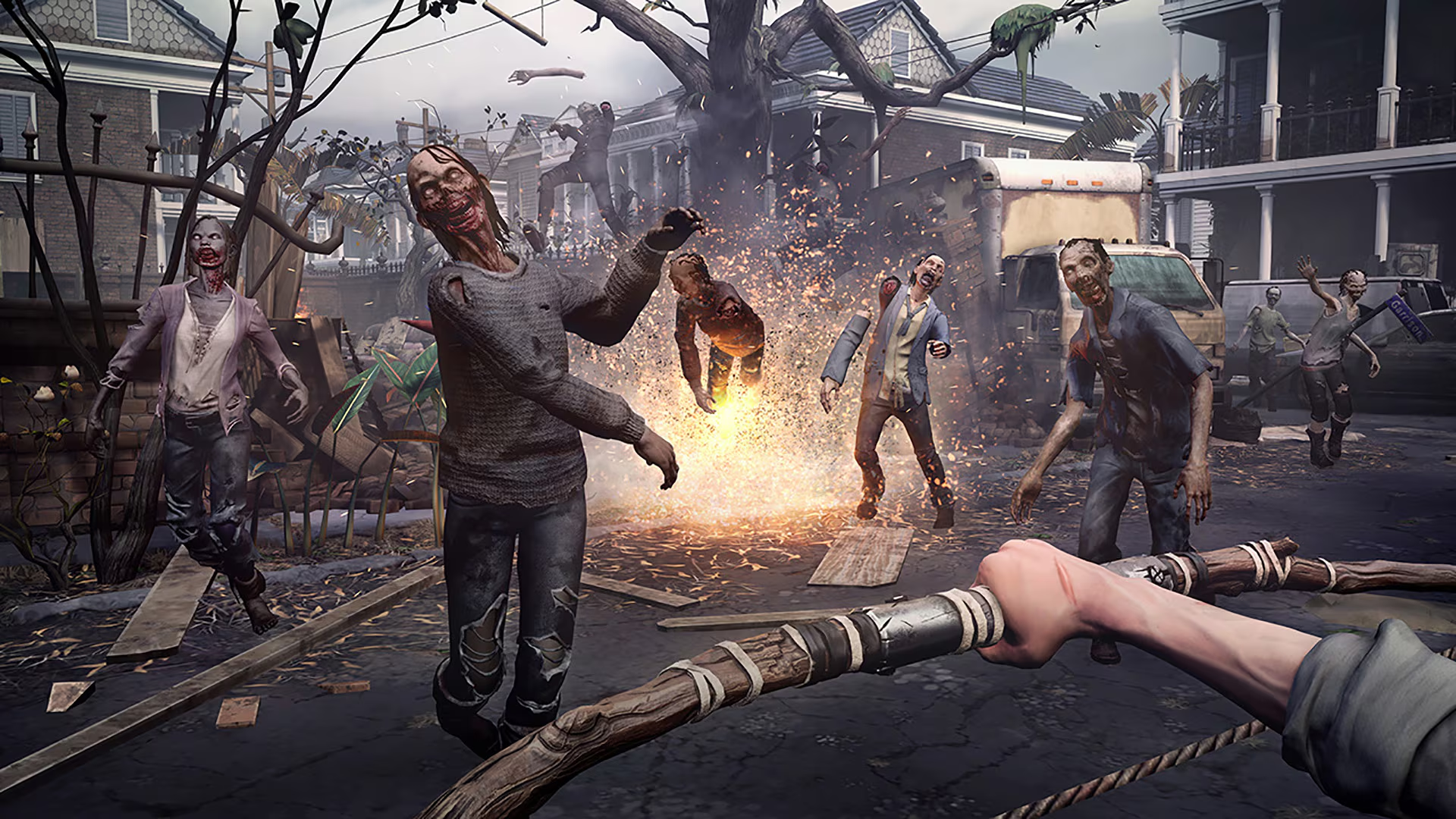The world within “The Walking Dead” franchise holds many stories. From Rick Grimes to Clementine to Lee, there are others that exist, such as “The Walking Dead: Saints and Sinners.” a 2020 Skydance Interactive and Skybound Entertainment release. Playable exclusively in VR, see firsthand the world where the dead roam the earth and the living trudge their way through the undead world just to survive… “Fight the dead. Fear the living.

Story and Environment
The Walking Dead: Saints and Sinners follows the story of the unnamed player character who simply goes by the title of “The Tourist.” The difference of the Tourist being Masculine or Feminine is up to the player, relaying the implication of allowing players to integrate themselves into the shoes of the Tourist. Travelling into the overrun and flooded city of New Orleans, Louisiana, the player must locate “The Reserve.” A military bunker full of supplies, weapons, and medicine that would surely give an edge to the player in times of the apocalypse. Travel amongst 9 different locations, scavenging, looting, sneaking, and fighting in places across New Orleans, while not completely accurate, are depictions of real world locations.
The player may make decisions that pertain to how the story unfolds as they go, such as choosing which characters live or die. To add to the already harrowing hostile environment, the game follows a time and day-based system where time management is crucial. As each day passes, supplies and survivors dwindle, but the number of dead increases. Upon sundown, players may experience the “Tower bell” that chimes, drawing the dead in multiple numbers if the player fails to leave before nightfall. This either forces the player to manoeuvre their way to the exfil boat, or stay and fight the hordes to their content.
Although, it should be mentioned that after both, the story, and the “Aftershock” content is completed, the game leaves a large void of direction other than simply looting buildings that the player would have already looted, shooting hostile human NPCs, or fending off the undead.

Gameplay
The overall feel of The Walking Dead: Saints and Sinners really immerses the player, giving them a multitude of factors to consider when surviving. Hunger, thirst, health, and stamina play a vital role in maintaining one’s odds of surviving an expedition. Food and drinks found whilst on an outing retain a “dirty” debuff, making the player “sick” by decreasing the health bar. It isn’t until the player uses medicine that returns the health bar back to its natural state. Weapons, including firearms and two handed melee weapons, have a simulated weight, making them feel clunky and heavy. This is extremely evident when the player attempts to use a firearm, simulating the “tourist’s” inexperience of handling one.
The combat in The Walking Dead: Saints and Sinners is definitely noteworthy. Gunfights draw zombies, essentially creating a three-way, sometimes four-way, battle between the living and dead. Weapons each have a durability metre, making the implication of choosing one’s battles all the more crucial. Ammo is limited, the dead are vast in number, and most good weapons and gear are tucked away and safeguarded by rivalling humans. Another thing of note is the stamina mechanic. While a player might have all the strength in the world to fight to their heart’s content, the game invokes a stamina metre, limiting the player’s abilities of combat and movement.

Visuals, Graphics, & Immersion
Running off of Unreal Engine 4, The Walking Dead: Saints and Sinners delivers a great experience in Virtual Reality. The already haunted setting of New Orleans pushes an even more dreadfully spooky environment by invoking overwhelming darkness, zombies that can seemingly appear out of nowhere, and even more dangerous locations such as claustrophobic schools or houses that have long since been abandoned that now remain infested. In many cases, the player will be forced to use a flashlight that must remain tended to. To keep the player on their toes, the developers implemented a timer system on the flashlight which requires the player to grab and shake the device to keep it activated for long periods of time. While the zombies have been masterfully done, humans can seem very “dumb” or unresponsive to situations. This can break immersion regularly as in many cases, entire groups of humans can be overrun by a measly one to two walkers. But beyond that, other immersive aspects include the use of zombie camouflage, lower quality firearms jamming often, and the even the simplicity of applying bandages by having the player manually wrap it around their arm.

Summary
The Walking Dead: Saints and Sinners is quite possibly one of the best VR zombie survival games to this day. With well-rounded mechanics that simulate the stressful and difficult nature of surviving in post-apocalyptic New Orleans. Not for the faint of heart, Saints and Sinners is, within itself, a good zombie survival title, even for those who do not take interest in the story of “The Walking Dead.” While post-main story and Aftershock content, the game may seem repetitive, it does not lack in terms of immersion, even going as far as catching even the most experienced of survivalists off guard at times.
Pros
10-20 hours worth of content to explore and enjoy
Multiple choice route for the main story, each with different outcomes that may affect the player positively or negatively
Immersive and spooky environment with well done mechanics and controls
A better title than the sequel by leagues
Cons
Post-Story and Aftershock content makes the game lacklustre
Human NPCs can mostly feel inhuman with their actions and reactions to situations which can sometimes break immersion
While gunplay can be immersive due to weight, it can, at times, seem to be too much, making weapons seem heavier than they should
